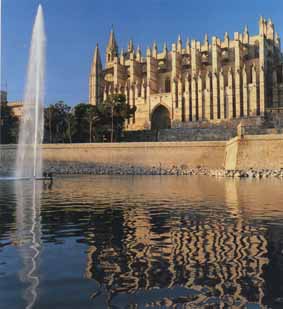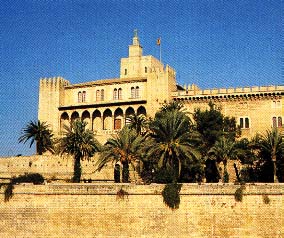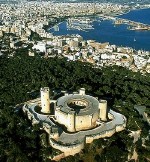LA
CIUDAD
La capital
de la Comunidad Autónoma de las Islas Baleares es Palma de Mallorca, elegida
como sede de la Universiada de 1999. Situada al sur de la Isla, con una
población de 350.000 habitantes, tiene buenas comunicaciones por tierra
con los cuarenta y nueve municipios restantes que cubren los 3.640 kilómetros
cuadrados de extensión. Por mar están cubiertos los servicios con los
principales puertos del Mediterráneo y por aire las rutas se encaminan
a todos los lugares del mundo. (Información
de vuelos del aeropuerto
de Son Sant Joan)
La Ciudad
, con una superficie de unos 200 Kms2 ,que ha conocido diferentes
culturas fue fundada por los romanos en el año 123 antes de Cristo, y
los vestigios que han quedado de tantas civilizaciones no han impedido
que actualmente esté en consonancia con los tiempos modernos. (Más
Historia)
Paralelamente
a los actos deportivos de la Universiada
será de gran relieve la oferta cultural que se iniciará este mismo año
con la celebración de conferencias a cargo de destacados dirigentes y
deportistas de élite, exposiciones de afamados pintores, etc.
Otras páginas
relacionadas con Palma
Hotel
Colon | Ayuntamiento de Palma
| Hoteles | Mapas
de Mallorca
Playas : Playa
de Palma , Playa de Can Pere Antoni y Cala Mayor .
Links: Monumentos
| Agencias
de Viajes | Rent
a car | Restaurantes
| Gimnasios | RCD
Mallorca
Photos : Playa de
Palma , Catedral , Castillo de Bellver , Plano de Palma , Almudaina ,
Fundacions:
Miró - La
Caixa - Sa Nostra.
Mercados: Diarios
- Rastrillo Sábados ( Avenidas ) - Artesanal lunes , viernes y sábados
(plaza Major).
Still
under constructionMercados
|
Ferias
y mercados
|
Lugar
|
| CAMP
REDÓ |
Cotlliure
Tel. 971 29 39
61 |
| CA'N
PASTILLA |
Pz. Pius
IX |
| MERCAPALMA |
Cardenal
Rosell s/n
Tel. 97126 44
62 |
| OLIVAR
|
Pz. Olivar
Tel. 971 71 27
48 |
| PEDRO
GARAU |
Pz. Pere
Garau
Tel. 971 27 32
83 |
| SAN FERNANDO
|
Avda. Sant
Ferran s/n |
| SANTA
CATALINA |
Pz. Navegació
Tel. 971 73 07
10 |
| S'ESCORXADOR
|
Emperadriu
Eugènia s/n
Tel. 971 26 04
00 |

|
Port and
Cathedral |
HISTORY
Palma, capital of Mallorca and of the Illes Balears, it was founded the
year 123 aC. for the Roman consul Fifth Cecilio Puts it, developing you
as strategic point of the trade in the Mediterranean. He receives the
name of Palma, for the palm leaf, as symbol of victory.
Toward the year 903 D.C., it was invaded
by the troops of the emir of Córdoba. The Muslims baptized her Medina
Mayurca and it was one of the cities but important of the Al-Andalus,
becoming commercial center of the western Mediterranean. The Islamic domain
lasted three centuries.
The king Jaime I conquered it to the Muslims
the year 1229, becoming governed, inside the Kingdom of Mallorca, by Jaime
II together with the Rosellón and Montpellier. He incorporated to the
Calatano-Aragonese crown the year 1349.
The XVI century it is characterized by
a great insecurity due to the Turkish pirates.
Was because of the Ordinance of New Plant,
starting from the XVIII century, when its history is bound to the rest
of the Spanish State.
VISITS:
-Catedral. Known popularly as "la
Seu", it is the artistic but representative monument of the Illes
Balears. It was initiate their construction for the king Jaime II and
it was completed totally the year 1.601. The material employee for his
construction was the stone of Santanyí. Their towers have 60 meters of
altitude with 9 bells.
Has three portals: Mirador, Almoina
and Major.
The rosettes give a majestic aspect
to the interior that has three ships and eight chapels. Of the chapels,
the Major and the Trinidad they are of great beauty.
Its worthy of admiring, the cloister, the
pulpits, the room to surrender, the tombs and the treasure.

-Palacio de la Almudaina. Old Muslim
strength located beside the Cathedral that the I laughed Jaime II make
in real residence and place of the court. It highlights among the 4 towers,
that of the l'Àngelhomage, built by the Muslims. They have been
indications of culture talayótica and it is believed that it is the headquarters
of the first urban establishment of Palma. At the moment it is the headquarters
of the General Captaincy of Balearic and official residence of the Kings
of Espanya Don Juan Carlos I and Mrs. Sofía, those which during their
stays in Palma, in the Sala Major, they offer their official receptions.
-Claustro de San Francisco. It works Gothic of slender columns.
It was built between the year 1287 and the 1390, it is one of those but
beautiful of Palma, he is inside San Francisco's Convent where Fray Junípero
lived it Saws before his evangelizing departure for lands of California.
Inside the church it is the tomb with the philosopher's remains and theologian
mallorquín Ramón Llull.
-La Llotja. Of Gothic style of the XVI century, building from where
it was regulated and it protected the trade and the port was administered.
It was built among the years 1421 and 1448. The windows gives him an excellent
illumination. It is historical-artistic monument and at the moment it
is dedicated to exhibitions and cultural activities.
-Baños Arabes. They are one of the few vestiges of the Muslim architecture
in Mallorca. They have their orígen at the end of the XI century. There
is documentation of five Arab bathrooms and one is only conserved in the
Street of Ca`n it Salas, 7. Of this last one, the room of the bathroom
of vapor is only conserved.

|
Castle
of Bellver |
-Castillo de Bellver. In a circular
way, as much their towers as the enclosure, are one of the first panoramics
that are come when arriving for sea. It is located 140 meters of altitude.
Their construction was ordered by the king Jaime II and its works began
among the years 1309 and 1311.
-Historical center.
-Patios típicos.
-Monasterio La Real.
-Cuevas of Génova.
-Pueblo Español.
Surface: 200 Kms².
Inhabitants: 303.485
Holidays: 20 January (San
Sebastián) - 31 December (Party of the Banner).
|

